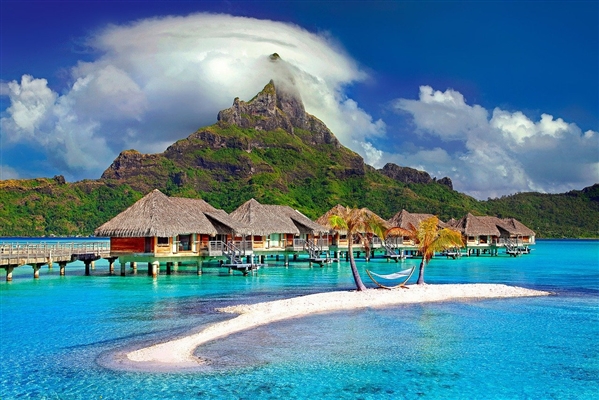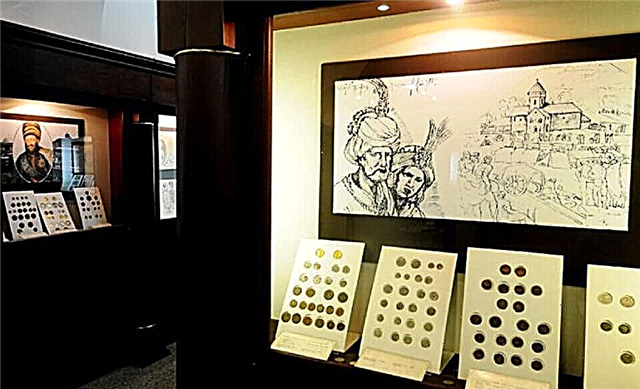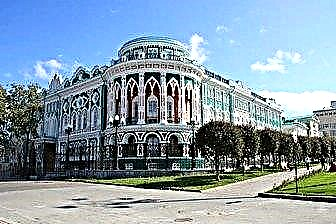The unofficial capital of the Urals ranks 4th in terms of attractiveness for tourists among Russian cities. This is not surprising, since the city really has a lot to see. There are about 600 architectural and cultural attractions here, of which 43 are federal monuments.
To help the traveler, since 2011, there is the Red Line route, passing through all the main beauties of the city. But outside of it, tourists will be able to see interesting places: parks, museums, temples, estates and theaters.
Today Yekaterinburg is actively developing and looks to the future with confidence. It is a modern city with a glorious past - a cultural, economic and industrial center of the promising Ural region.

The best hotels and hotels at affordable prices.
from 500 rubles / day
What to see and where to go in Yekaterinburg?
The most interesting and beautiful places for walking. Photos and a short description.
Sevastyanov's house
The palace of the first quarter of the XIX century, built according to the project of A. I. Paduchev in the architectural styles of pseudo-Gothic, neo-baroque and Moorish tradition. It was under N. Sevastyanov that he acquired modern features, since after the purchase of the building, Nikolai Ivanovich decided to engage in its reconstruction. Perhaps today this building is the most striking attraction of Yekaterinburg.

Observation deck of business center "Vysotsky"
The open area is located on the 52nd floor at a height of 168 meters. From here you can see the whole Yekaterinburg at a glance. Visibility is said to exceed 25 km in good weather. This place is perfect for romantic dates and wedding photo shoots. Tourists can take an audio guide to listen to an excursion while admiring the city landscape and learn interesting facts from the history of Yekaterinburg.

"Dam"
The dam of the city pond on the Iset River, which the townspeople affectionately call "Plotinka". It was built in the 18th century and has been reconstructed several times since then. From an architectural point of view, the structure is an ordinary bridge. However, it is of particular importance for the residents of Yekaterinburg - dates are made here, skaters and skateboarders gather, and newlyweds come to be photographed.

Weiner street
Central alley of Yekaterinburg, the so-called "Ural Arbat". One of its parts from the street. Kuibyshev to Lenin Avenue is pedestrian. Weiner Street is one of the oldest in the city; it was founded in the middle of the 18th century. Along it there are merchant mansions, town estates, former trade shops, administrative buildings, most of which were built at the end of the 19th - first half of the 20th centuries.

Estate of the Rastorguevs - Kharitonovs
The architectural and park ensemble on Voznesenskaya Gorka, erected in the 18th-19th centuries according to the project of T. Adamini. The complex is built in a classical style, which is distinguished by an abundance of columns, triangular porticos and arched galleries. The last major reconstruction was carried out in the 1930s, so now most of the buildings are in an unsatisfactory condition.

Ganina Yama
Ganina Yama is an abandoned mine near the Four Brothers tract. Iron ore was mined here in the 19th century. Nowadays, only a small quarry and several dozen wooded mines remain from the deposits. The place is famous, first of all, for the fact that the bodies of Nicholas II and his family were destroyed here after the execution. Today, on the site of the mine, there is the monastery of the Holy Royal Passion-bearers, founded in 2000.

Yeltsin Center
A cultural and educational center dedicated to the modern history of Russia, as well as the personality of its first president, Boris N. Yeltsin. The institution is quite active: there are exhibition rooms, a cinema, auditoriums for lectures and conferences, a library and a science amusement park. The center was established in 2008, partly with government money, and partly with the personal funds of the Yeltsin family.

Museum of the History of Yekaterinburg
The collection occupies a historic building of the 19th century, which at various times served as a tenement house, a library, a noble estate and a communal house. The museum opened in 1940. In addition to the main exposition, tourists are invited to look at the wax figures of Peter the Great, Catherine II, Nicholas II, the Ural manufacturers Demidovs and the founders of Yekaterinburg.

Yekaterinburg Museum of Fine Arts
The largest art museum in the Urals. Its exposition is exhibited in two branches: in the former railway hospital and in the building of 1986 on the banks of the Iset River. The gallery appeared in the city in 1936, its funds were formed due to works transferred from the State Hermitage, the Museum of Fine Arts. Pushkin and the Tretyakov Gallery.

Museum of the History of Stone Cutting and Jewelry Art
A unique collection consisting of semi-precious minerals, works of jewelers and stone-cutters of the Urals, and products created at the Ural Lapidary Factory. The museum has the Malachite and Bazhov Halls, the Emerald Room and several more exhibition galleries, where visitors can see the skillful works of local craftsmen made of colored stone and metal.

Sverdlovsk Regional Museum of Local Lore
The museum was founded in 1870 at the initiative of the Ural Society of Natural Science Lovers. At first, its collection consisted of four departments: mineralogical, botanical, zoological and paleontological. Later, a numismatic, ethnographic and anthropological section was added. To date, its funds include more than 700 thousand exhibits.

Old train station
The station building was built in 1878 according to the project of P.P. Schreiber. After 1914, the station was used only for serving military echelons. In 2003, after a large-scale reconstruction, a museum was opened here, dedicated to the history of the Sverdlovsk railway from the creation of the first steam locomotive to the modern period. On the square in front of the museum, there are sculptures depicting the professions of railway workers.

Opera and Ballet Theatre
The opera troupe has existed in Yekaterinburg since 1879, but only in 1912 a separate building was built for performances on the site of the old wooden circus, designed for 1200 spectators. The opera "A Life for the Tsar" by M. Glinka was staged at the opening. Since 1914, the theater has acquired its own ballet troupe. Major reconstruction of the building was carried out in the 1980s.

Yekaterinburg circus
The circus building is located on the banks of the Iset River. It was erected in the 1980s and at that time was considered one of the best in the USSR, since its design made it possible to stage complex circus acts. Since its opening, more than 20 million spectators and many famous groups from Russia and the world have visited it. Such masters as M. Zapashny, T. Durova, T. Nugzaro, V. Doroveiko worked here.

Yekaterinburg Zoo
The city zoo has been operating since 1930. Today it is home to about 400 species of animals, of which 70 are listed in the Red Book. Heat-loving animals live in five pavilions, in outdoor enclosures there are inhabitants of cold latitudes habitual to the harsh climate. In the zoo you can see Amur tigers, bears, and birds of prey. Every year the management tries to acquire new animals.

The building of the Sverdlovsk City Council
An administrative building that was built from the end of the 19th century to the 1950s. Before the revolution, it housed a seating yard, later - departments of the regional museum.In the 1930s, the building was completed, decorated in the style of constructivism, after which various city organizations were placed in it. Later reconstructions added features of the monumental Stalinist Empire style to its appearance.

Temple on blood
The temple was erected in the 2000s on the site where in 1918 the Bolsheviks shot Emperor Nicholas II and his family. Previously, the mansion of the engineer Ipatiev stood here, where the crowned persons spent the last days of their lives. The church was built in the Russian-Byzantine style by several architects. Currently, it is a pilgrimage center for believers from all over Russia and Orthodox Christians from abroad.

Temple of the Lord's Ascension
One of the oldest churches in the city, which was built in the late 18th - early 19th centuries. In its appearance, you can notice the features of the Baroque, pseudo-Russian style and classicism. The main relic of the church is a particle of the relics of St. Simeon of Verkhoturye. Due to the fact that after its closure in 1926, the temple housed a museum, it did not fall into desolation like many other religious buildings. Services resumed in 1991.

Temple Big Chrysostom
The fate of Bolshoi Zlatoust repeats the fate of the Cathedral of Christ the Savior, since both of them were completely destroyed during the Soviet regime and rebuilt after its departure. A modern building on the site of the historical one was erected in 2013. Initially, a more ambitious project was conceived, but the result was a bell tower - a type of religious structure common in the 15th - 16th centuries.

Novo-Tikhvin monastery
The women's monastery, which began its history in the 18th century with the opening of an almshouse. By the beginning of the 20th century, more than 100 nuns and 900 novices lived here. The monastery complex included six churches, workshops, an orphanage, a hospital, a bakery, and a library. After the closure of the institution in the 1920s, the monastery fell into disrepair. Its revival took place in 1994. At the moment, many buildings have been restored and restored.

Monument to Tatishchev and de Gennin
Wilhelm de Genin and Vasily Tatishchev are the founders of Yekaterinburg. They initiated the construction of a metallurgical plant, from which a whole city later grew. The monument was erected in 1998 on Labor Square. The author of the project was the Moscow sculptor P. Chusovitin. The bronze composition was made at the Uralmash plant and installed on a powerful pedestal.

Monument to the keyboard
A modern art object (land art sculpture) made in 2005 by A. Vyatkin. Despite the fact that the attraction was never recognized as an official monument, it is included in all unofficial guidebooks around Yekaterinburg and is a must-see for many guests of the city. The famous tourist route "Red Line" starts from here.

Shartash stone tents
Granite formations near Lake Shartash, located within the city limits. Here, the townspeople love to relax, ride bicycles and ski, have picnics in good weather. Before the October Revolution, secret meetings of the Ural Bolsheviks were held here under the leadership of Ya. M. Sverdlov. The height of the formations is from 5 to 18 meters. They look like flat boulders piled on top of each other.

Yekaterinburg arboretum
The arboretum consists of two separate parks, which are located on 8 Marta and Pervomayskaya streets. The second was established in 1932 as a landscaping research station, the first appeared in 1948. Several hundred species from regions of temperate and sharply continental climates grow on their territory. There are also nurseries, greenhouses and greenhouses for plants accustomed to the sun and heat.

Kharitonovsky Garden
Landscape park in the English style, located around the estate of the Rastorguevs - Kharitonovs. The garden was laid out in 1826 at the request of the owners. In the center there is an artificial reservoir with an island on which a rotunda gazebo rises. It should be noted that this architectural structure appeared in the park only in the 1930s during the reconstruction of the estate. Volunteers are currently looking after the park.












